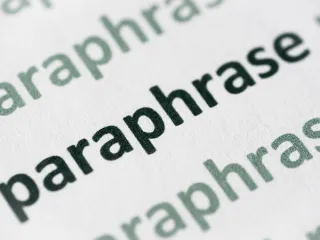Academic writing isn’t a piece of cake. It takes some serious skills, loads of patience, and a dash of perseverance to whip up a top-notch paper. But now, let’s dive into the nitty-gritty: what are the pros and cons of academic writing, and how can you conquer them? Let’s take a look at the ups and downs of academic writing and toss in some handy tips and tricks to help improve your writing.
In an effort to make your research paper both snappy and captivating you want to have the right formatting. And oh, don’t forget a reference page – it’s like giving a nod to the authors who have influenced your work, not just a boring list of where you got your idea. To keep your research on point, you gotta nail that formatting.
When it comes to academic papers, one style that’s all the rage is the American Psychological Association (APA) format. This format is usually used for psychology, social sciences, and educational papers. It shows you how to format a research paper when to use headings and subheadings, rocking the title page and abstract, giving credit where it’s due with citations and references, and making your tables and figures look amazing.
In this article, we’ll take a closer look at how to format your research paper, and have you presenting a polished paper in no time.
Parts of a Research Paper Format
Research typically starts with an important question. Next, researchers observe, follow rigorous methods, and record the origin of their information. Therefore, understanding the vital components of a research paper – from the abstract to the methodology to the appendices – is essential.
To facilitate comprehension of these complex components, we have created a clear layout with sections that are specifically designed to enhance research clarity.
Cover Page
The cover page introduces your research paper. It prominently displays your title, name, affiliated institution, and in certain instances, a unique running head. It’s essential to ensure accuracy here, especially when following journal article requirements. Sometimes, extra details like a course code or submission date might be required.
Abstract
The abstract provides a concise overview of your research. It outlines the objective, methods adopted, principal findings, and conclusions drawn. Aim for 150-250 words, ensuring it accurately represents the paper’s core content.
Introduction
Here, the emphasis lies on your thesis statement. This section sets the context, giving a sense of direction for the paper’s topic and relevance. For those wanting a broader overview, the table of contents can guide the paper’s subsections.
Background
The background delves into prior studies and literature. Using parentheses for any clarifications is a good indication of existing knowledge and highlights any research gaps, emphasizing the need for your study.
Methodology
In the methodology section, explain how you plan to research and write. This covers aspects from selecting participants to data collection and analysis methods, offering readers a clear insight into your research process.
Results
The results section showcases your research findings. The use of data visuals such as tables or charts can be beneficial. Make sure these visuals are properly labeled and seamlessly integrated into the narrative.
Conclusion
The conclusion revisits your thesis statement, analyzing the results in that context. It offers insights, addresses potential limitations, and suggests future research avenues. In other words, it summarizes all the key points of your research within one subsection.
Appendices
Finally, appendices provide supporting material. This can range from raw data to detailed methodologies. For clarity, make sure each appendix is labeled and referenced in the main body where relevant.
In addition, the use of an edu-checker is indispensable for verifying the reliability and accuracy of academic sources. Plagiarism detection tools such as Quetext can ensure the originality of your work and avoid unintentional plagiarism.
How to Format a Research Paper (Step-by-Step)
Choosing the best writing style for academic research is critical to ensuring clarity and consistency in scholarly communication. There are three primary style guides in the academic field: APA, MLA, and Chicago.
The APA style, created by the American Psychological Association, is the recommended format for many scholars in psychology, education, and the social sciences. This style is weighty because it focuses on the date of publication, enabling readers to easily track the chronological progression of research. The style reflects the dynamic and evolving nature of these fields.
In contrast, the Modern Language Association developed the MLA style, which is commonly used in the liberal arts and humanities. The MLA style puts a strong emphasis on authorship, highlighting the value of original thought and interpretation in these disciplines. This makes sure that credit is always given where it belongs.
Finally, the Chicago style is suitable for various academic fields. It is recognized for having two documentation systems that support both sciences and arts. Also, its flexibility allows researchers to adjust the style to their individual requirements.
Overall, following these instructions is crucial to maintaining the integrity and clarity of academic writing.
How to Format an APA Paper
To use APA style correctly, you need a good understanding of its specific guidelines. Your work can gain more credibility if you follow these principles. To avoid harming your reputation as a researcher, you must be vigilant in avoiding plagiarism.
Here’s a detailed breakdown of drafting an impeccable APA paper:
- Margins: Ensure 1-inch margins on all sides. This uniform space provides a clean, professional appearance.
- Fonts: Use standard fonts to guarantee readability. Predominantly, Times New Roman (12 pt) or Arial (11 pt) are recommended.
- Spacing: Implement double space throughout the document, starting from the first line. This spacing promotes clarity and leaves room for potential feedback.
- Running Head & Header: For papers aimed at publication, a shortened version of your title, the running head, should grace every page. It should be placed in the header.
- Paragraph Indentation: Use a half-inch indentation for every new paragraph. This differentiates content segments and aids in directing the reader.
- Title Page: An essential element in the APA format. It provides essential details including, the paper title, author’s name, institutional affiliation, course name, instructor’s name, and due date.
- In-text Citations: When you paraphrase or use quotation marks to cite another’s work, in-text citations are crucial. It’s an acknowledgment of the original work and offers a reference for your audience.
- Abbreviations & Italics: Avoid non-standard abbreviations. For titles of books or periodicals, use italics. Likewise, major headers within the paper should also be in italics.
- Endnotes: These should be placed on a new page at the end of the paper, just before the reference section. They offer additional comments or context about a particular part of your content.
- Graphs & Numerals: Graphs should be clearly labeled. When beginning a sentence with a number, it should be spelled out, but in other cases, use numerals.
- Methodology: Particularly for research papers, clearly detailing your methods is crucial.
- Punctuation: Pay attention to the consistent use of commas. In a list of three or more items, the APA style suggests using a comma after every item, including before ‘and’ or ‘or.’
How to Format an MLA Paper
The Modern Language Association, abbreviated as MLA, is a style guide used mainly in humanities, such as language and literature. This guide explains the details of MLA style:
- Font: Always opt for “Times New Roman.” While “Arial” is commonly used in other formats, Times New Roman remains the preferred choice for MLA style.
- Size: A consistent font size of 12 pt is ideal, balancing readability and aesthetics.
- Consistency Across Styles: Like the APA format, the MLA style requires the use of 1-inch margins on every side of the document. This ensures uniformity and easy printing.
- Double Space: It’s vital to double-space the entirety of the paper, a trait shared with the APA paper style. This practice offers a tidy look and enhances readability.
- Paragraph Starts: The first line of every new paragraph should be indented half an inch, creating a clear separation between ideas.
- Capitalization: All headings should be capitalized for emphasis. It’s not only about following the format guidelines but also ensuring clarity.
- Numerals: Use Arabic numerals when referencing figures, graphs, or making points.
- Content: The topmost page of the document – often referred to as the “new page” in formatting discussions – should feature vital details. This includes the full name of the author, the instructor’s name, course details (name and number), and the submission date.
- Parenthetical Methodology: Unlike the APA style, which heavily leans on author-date methodology, the MLA style favors parenthetical citations. Here, in-text citations are neatly wrapped in parentheses. If paraphrasing, ensure you still credit the sources.
- Directness: The parenthetical citations directly guide the reader to the Works Cited page, which is especially beneficial in humanities papers where one might cite multiple works by the same author.
- End of the Paper: Positioned at the end of the paper, the Works Cited page enumerates all sources cited within the document.
- Endnotes: If necessary, use endnotes to provide additional context or clarification, which should appear before the Works Cited page.
- Quotation Marks & Italics: When quoting directly, employ “quotation marks.” Book titles and other large works should be italicized. Do not underline them in MLA style.
- Header: Include a title with your last name and the page number on every page.
- Commas: In your Works Cited, use commas to separate elements within each listing.
- Conclusion: Adhering to the MLA style isn’t just about fulfilling a checklist; it’s about preserving a uniformity acknowledged and esteemed in scholarly circles.
How to Format a Chicago Paper
The Chicago style provides a more detailed method of writing that can be modified to fit a range of academic subjects. In contrast to other references such as the APA and the Modern Language Association (MLA) style guides, the Chicago style is more adjustable, which makes it easier to use. The following is a thorough analysis:
- Standard: In Chicago format, stick with recognized fonts. Times New Roman is a gold standard.
- Alternatives: While Times New Roman is prevalent, one might occasionally see Arial or others. Ensure the font size remains at 12 pt.
- Standardization: Adopt 1-inch margins around the document. This mirrors the format guidelines in an APA paper and those dictated by the Modern Language Association.
- Flexibility: While 1 inch is standard, slightly larger margins might be suitable based on individual preferences or document requirements.
- Requirement: Ensure to double-space the entire document. This spacing technique aligns with both the APA format and MLA style.
- First Line: Each new paragraph should start with a half-inch indentation from the left margin. This “first line” methodology ensures clarity and structure.
- Position: Incorporate numerals in the top right corner or at the page’s bottom. It’s essential to maintain consistency throughout the document.
- Comparison with APA: Unlike the APA style, where a header often accompanies page numbers, Chicago focuses on simple numeral representation.
- Not Mandatory: Unlike APA and MLA format guidelines, a title page is optional in Chicago style.
- Streamlining: This absence eliminates redundancy, especially when the title and crucial details appear on the first page. This strategy ensures readers concentrate on content over mere formality.
- Endnotes: Chicago style often incorporates endnotes, ensuring references don’t clutter the main content. It’s placed toward the end of the paper.
- Italics and Underline: Use italics for titles of longer works. Avoid the underline function, as it can be mistaken for hyperlinks in digital documents.
- Quotation Marks and Paraphrase: Ensure direct quotes are within “quotation marks.” Paraphrase when direct quotes aren’t necessary, but always attribute the source.
- Graphs and Illustrations: If the research includes graphs, ensure they’re clearly labeled and sourced.
- Punctuation: Be cautious with commas. Follow the punctuation rules specified in the Chicago manual.
Additionally, a practical outline example for research papers can be invaluable for those seeking a clear understanding of research paper structures.
Summary
Academic essays must not only have high-quality content but also follow precise formatting rules. There are three main writing styles for academic papers: APA, MLA, and Chicago. APA is the most commonly used style in psychology and education, and it prioritizes in-text citations and a comprehensive reference page.
In humanities, the MLA style stands out because of its in-text citations and works cited. On the other hand, the Chicago style, which uses endnotes or footnotes, covers a wider academic territory.
However, apart from formatting, it is essential to maintain the content’s integrity. Always express your ideas clearly, and make sure you accurately cite all the sources you use. Tools such as Quetext are changing this field by combining plagiarism detection with proofreading. Quetext’s DeepSearch Technology ensures comprehensive scanning to guarantee your research paper’s originality and error-free copy.
In academia, where precision is critical, a well-formatted research paper reflects your understanding of the subject and attention to detail. Quetext’s proofreading and plagiarism checker your content ensures that your work is unique and free from mistakes. Your paper can stand out academically by following established formatting guidelines and ensuring its originality.









